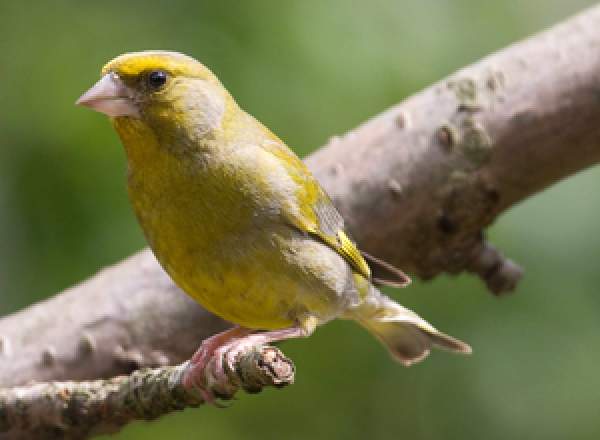Greenfinch
Carduelis chloris

Male Greenfinches are a dull olive-green, with greenish-yellow on the breast and rump, together with bright yellow wing flashes. Adult males also have bright yellow carpal joint (the alula feathers) and yellow to the edge of the tail. Females and immatures are duller in appearance than the adult males, with less yellow visible in the plumage. Juveniles are paler in colour and have streaked plumage. The size of the Greenfinch (similar to a House Sparrow) makes it easy to separate from the much smaller Siskin.
Greenfinches have a number of different calls, uttered either from a perch or given in flight, including a rapidly delivered ‘chichichichichit’ and the characteristic nasal ‘dzwee’, the latter commonly heard during the breeding season. The song usually consists of a mix of pleasant tremolos interspersed with some rather less-melodic tones and a rather nasal ‘chewlee’ note.
The recovery rate for Greenfinch is relatively high for a bird of its size, highlighting its close association with Man. The decrease in seed availability in the wider countryside has seen the decline in Greenfinch populations on farmland and this may mean that gardens and the food provided within them have become increasingly important, particularly during late winter and early spring when natural seed supplies are at their lowest level.
The emergence in 2005 of a disease (Trichomonosis) that was new to Greenfinches, hit the population hard, with a decline of c.20% in regional breeding populations during the year following the outbreak (Robinson et al. 2010).
Greenfinches have a relatively varied diet, the large bill enabling the species to take seeds of a wide size range. Greenfinches adapted readily to taking peanuts from hanging feeders, and more recently, have dominated feeders containing black sunflower seed and sunflower hearts. From early autumn and through until spring, Greenfinches become gregarious by forming feeding flocks.
Greenfinches tend to nest in rather loose colonies, with evergreen shrubs providing perfect sites for the placement of their nest, built with twigs, moss and grass, and lined with roots and hair. Most British & Irish breeders are resident, joined in winter by migrants from Scandinavia.
Find out more about Greenfinches on BirdFacts and the Wider Countryside Report.






Share this page